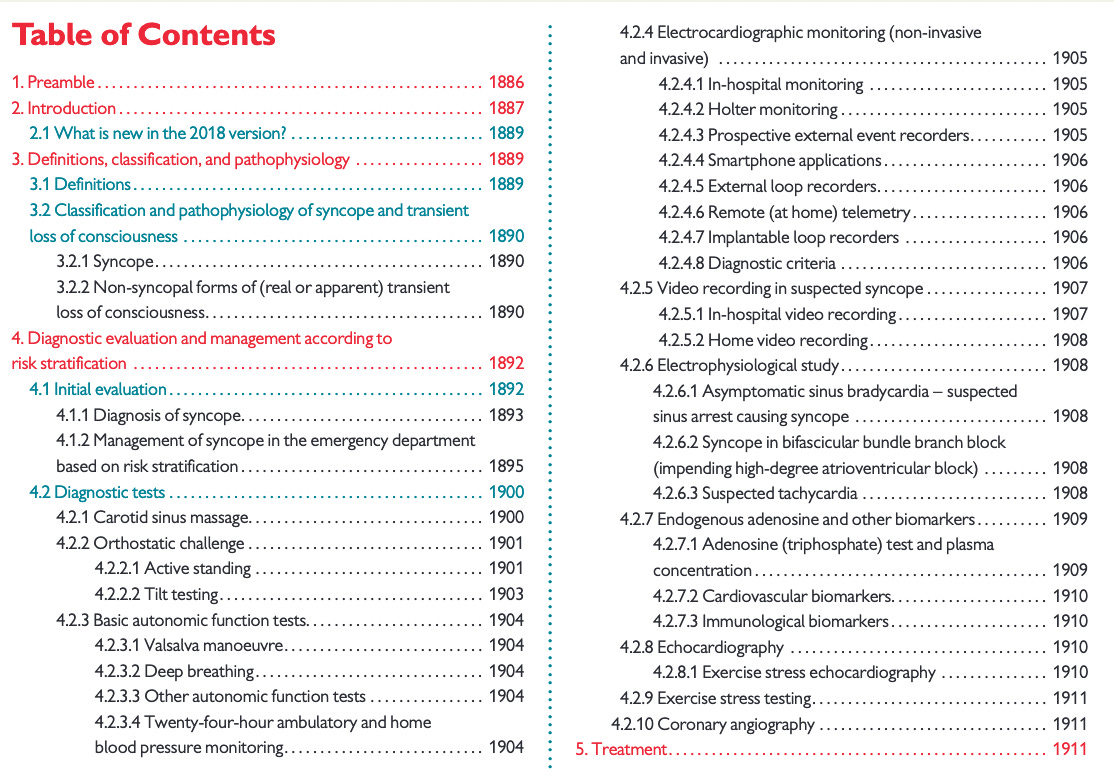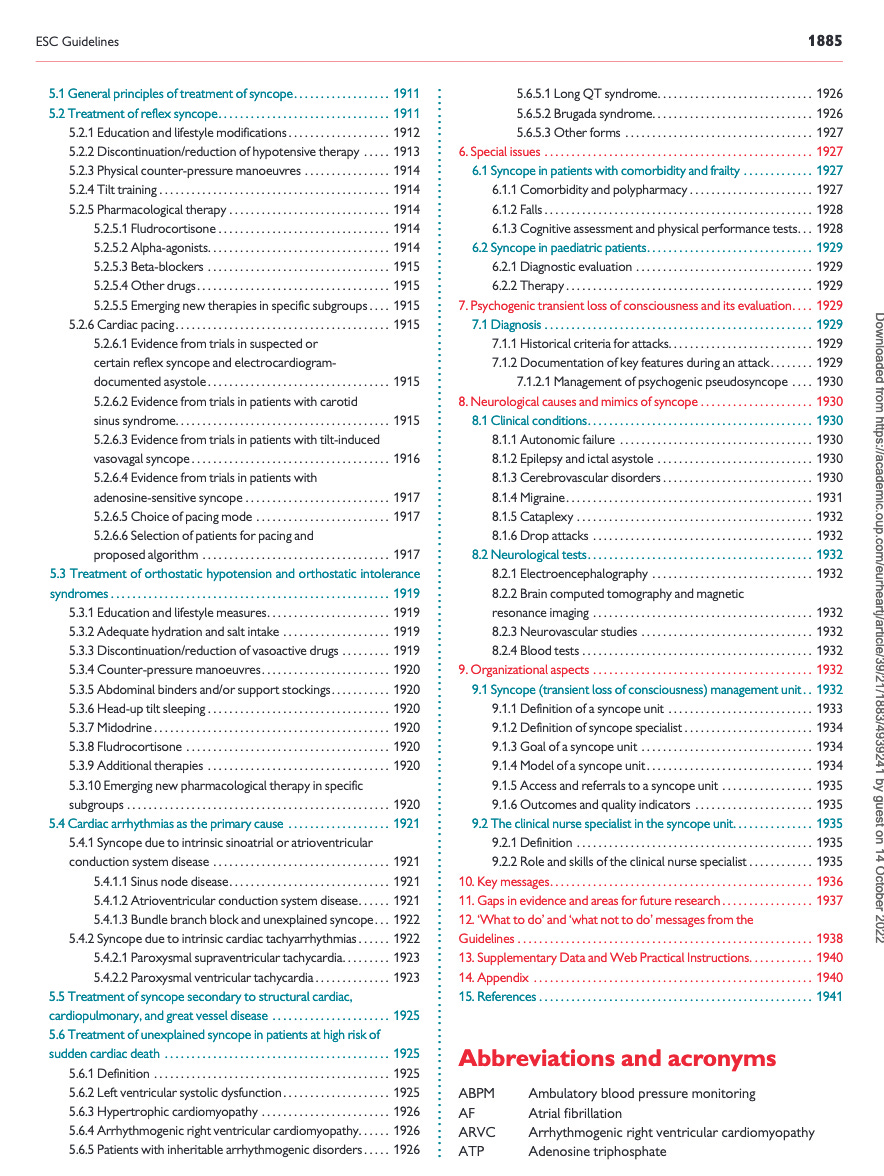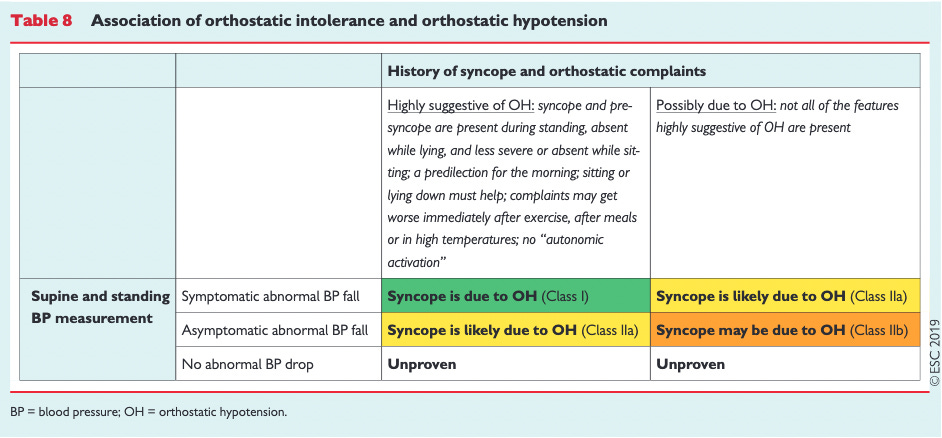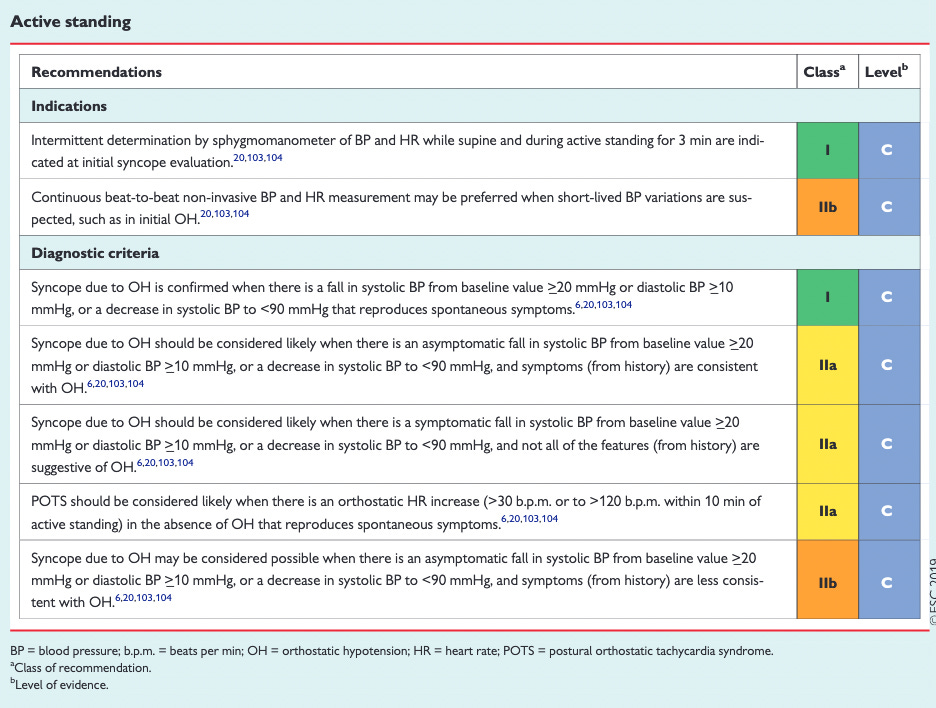The Diagnosis of Postural Orthostatic Tachycardia Syndrome (POTS)
Hint: It's Not Just the Tilt Table Test
The presenting symptoms of Postural Orthostatic Tachycardia Syndrome or POTS include dizziness upon standing, “gray-outs” or frank fainting (i.e., syncope) or transient loss of consciousness (TLOC). These episodes regularly happened to me after a severe car accident wherein my 2-year-old daughter and I were spun in a complete circle after being T-boned at 90 mph by a distracted driver. It took some months to “declare” a traumatic brain injury (and over a decade to get over it). Finally my subsequent diagnoses of diabetes insipidus and POTS unfolded over years, after dozens of doctors shook their disappointed heads at me for “pretending” to be ill. None of them had heard of dysautonomia, or POTS, which is a dysfunction of the autonomic nervous system; standing up makes one faint.
2018 ESC Guidelines for the diagnosis and
management of syncope
The Task Force for the diagnosis and management of syncope of the European Society of Cardiology (ESC) developed these guidelines with the special contribution of the European Heart Rhythm Association (EHRA). It was endorsed by the European Academy of Neurology (EAN), European Federation of Autonomic Societies (EFAS), European Federation of Internal Medicine (EFIM), European Union Geriatric Medicine Society (EUGMS), and the European Society of Emergency Medicine (EuSEM). The authors and Task Force Members were from Italy, Spain, The Netherlands, France, Austria, Sweden, Ireland, the UK, and Monaco.
Reference: European Heart Journal (2018) 39, 1883–1948 ESC GUIDELINES
doi:10.1093/eurheartj/ehy037
The 2018 ECS Guidelines for the Diagnosis and Management of Syncope
One can see that this is now a complicated and well-described topic, and a litany of tests may help with the diagnosis. After all, standing up and fainting is pretty hard to fake and these episodes must be reproducible.
If one has a high salt intake and drinks plenty of water, these episodes can be minimized, especially by compounding that by wearing compression stockings to avoid blood pooling in the legs upon standing. This means that symptoms can also fluctuate, with “good” days and “bad” days that depend on the weather, with hot weather being most detrimental for causing peripheral vasodilation and loss of body water and salt.
Making the Diagnosis of POTS
When I was sick around 2010, the diagnosis of POTS was a cardiologist’s clinical diagnosis based on history, followed up by a positive Tilt Table Test (TTT). In this test, I felt like Herman the Munster, being strapped to a table with velcroe straps across my chest and thighs. I was connected to an IV and an EKG so they could watch my heart rate and rhythm.
No one likes to faint… it feels like a gradual darkness that descends upon one, with a corresponding inability to prevent its takeover. One can either slip down gracefully, or try to catch ones self on the way down. Either way, you faint.

And the Table of Contents goes on:
The diagnosis of POTS is amenable to discovering the heart rate and blood pressure abnormalities. After making the diagnosis by clinical history and witnesses describing the event, the list of tests to be ordered may include:
Carotid Sinus Massage: massage one side of the neck at the carotid bodies (never do this at home, nor do it on both sides of the neck) to elicit a slowed heart rate.
Orthostatic Challenge: Bear in mind that an “automatic” blood pressure cuff done by just pushing a button is highly likely to fail to even read a blood pressure - the patient may faint before it is read, it may constantly read “Error” because it falls too precipitously, and a manual sphygmanometer may be necessary. Lastly, a noninvasive blood pressure monitor with beat-to-beat variability may be necessary. One can test in three ways by going from laying down to standing and checking the blood pressure (BP).
Active Standing: Upon standing, the systolic (top numeral) BP drops by at least 20 mmHg; OR the diastolic (bottom number) BP drops by at least 10 mmHg, OR a decrease in systolic BP to under 90 mm Hg. With neurogenic orthostatic hypotension, the heart rate may nor rise over 10 beats/minute versus that obtained laying down. Increased heart rate over 10 beats/minute is common with anemia or a low blood volume/dehydration. The relationships are summarized below:
Head-up Tilt. Mimics prolonged standing, especially for those with autonomic failure and delayed orthostatic hypotension. Tilt testing may be unavailable, with some centers no longer performing it in the USA.
The most commonly used testing pattern are either a trinitroglycerin (TNG) test of 300–400 mg sublingual TNG after a 20-min unmedicated phase, or the
low-dose intravenous isoproterenol test, which uses incremental
doses to increase average HR by about 20–25% over baseline (usu-
ally <_3 mg/min). For me, they used isoproterenol and I promptly passed out.24-hour Ambulatory Home Blood Pressure Monitoring. May be used but has limitations.
Basic Autonomic Function Tests: The Valsalva Maneuver: as if one is pushing out a hard stool, holding the breath and bearing down will decrease the amount of blood returning to the heart and may cause a fainting episode while on the commode. Deep breathing, other autonomic function tests may also replicate syncope. The blood pressure may also be monitored as an outpatient, although I was admitted for about a week to determine my effective dose of midodrine to avoid syncope.
Deep Breathing: since heart rate increases during inspiration (I) and decreases during expiration (E), heart-rate-variability or the E/I index is over 14 beats/min. Blunted variability is a sign of parasympathetic abnormality.
The Electrocardiogram (EKG): Monitoring the electric wave of the heart may occur in the hospital, through Holter monitoring worn at home, smartphone apps, external event recorders, remote telemetry, implantable loop recorders. There are diagnostic criteria at each turn, well described in the above manual.
Other Workup: may include video recording to observe the syncope at home or in the hospital, cold pressure on the back of the head with symptom alleviation, the sustained hand grip test, and mental math may be used.
Electrophysiological Study (EPS): Tests to see if a very slow heart rate, bradycardia at under 60 beats/minute, may be a cause that can lead to sinus arrest and syncope. EPS also may check for a bifascicular bundle branch block with impending high-degree atrioventricular block (where the heart’s electrical rhythm fails to descend from the upper atrial to the lower ventricular chamber), and/or a fast heart rate over 100 beats/minute, or tachycardia.
Adenosine triphosphate and other blood levels: blood level of adenosine, cardiovascular markers, and immunologic markers may also be checked in the plasma.
Echocardiogram: A 3-D sound wave test of the heart can measure the contraction of each heart chamber, as well as valves, and the blood flow from one part to another. It may be combined with an exercise stress test.
Exercise Stress Testing: running on a treadmill with an EKG attached may help diagnose problems with oxygen being delivered to the heart, especially during exercise.
Coronary Angiography: Through an incision in the upper groin area, a long catheter is used to inject dye through the heart’s arteries, showing any decreased blood supply that may be amenable to being repaired with a stent or with bypass surgery and replacement of a heart artery with the leg’s saphenous vein.
All these studies should be performed by a cardiologist or other doctor with specific expertise in POTS. In this manner, other heart disease considerations can be ruled in or out, leading to the most comprehensive evaluation.
Once the definitive diagnosis is made, the therapy is targeted to compensate for any weaknesses, and restore blood pressure and/or heart rate to normal so the symptoms disappear.
In our next article, we will go over a stepwise management plan to address symptoms by correcting the pathophysiology of the illness.
Affiliate Links
If my writings are helpful to you, please consider supporting our practice by purchasing your supplements, hydrogen water, and/or air filtration through us. All proceeds go into the business to keep costs down.
My most frequently asked question: “When do you sleep?" https://buymeacoffee.com/dra9
My second-most asked question: “Who do you go to for legal help?” How To Win In Court Without a Lawyer. Whether or not I have a lawyer, I love learning my rights! Too few Americans know what Justice is. Too many are denied Justice in our courts. For the past 36 years Dr. Graves has been an attorney and In 1997, he started his online course to help everyone who can't afford a lawyer by giving affordable legal know-how and solid confidence to tens of thousands of people for 25 years ... good people who now are winning in court without a lawyer!winning cases by doing what this course will show YOU how to do - step-by-step, quick & easy! www.HowToWinInCourt.com?refercode=AM0060
Z-STACK™ Supplements. by Beloved Dr. Vladimir Zelenko.https://zstacklife.com/?ref=MARGARETARANDA; Use CODE "DrMargaretAranda"
JuicePlus™ - Gummies for Kids: https://aranda.juiceplus.com
Alavida™ and Epithalamin. Alavida™ Regenerating Trio. Anti-aging patch, day and night cream; the only topical product in the world with epithalamin, a hormone produced by the pineal gland. WATCH how Low Level Light Therapy (LLLT) works:
LifeWave™ Wearable Patch Technology. Uses the above LLLT. Wearable technology for pain, Glutathione, Carnosine, X39 Stem Cell Activation with GHK-Cu, Insomnia, Athletic patches and more; no medication; uses LLLT, no drugs. https://lifewave.com/margaretaranda/store/products
Corganics™. Medical quality CBD with NO THC. May help pain, anxiety, depression, nausea, inflammation, topical skin disease. Capsules, sublingual liquid, and topical. Approved by dermatologists for skin conditions like psoriasis; also by oncologists for nausea. https://corganics.com - Use CODE “Aranda” (case sensitive).
ECHO H2® WATER. Bubbles hydrogen gas (H2) into water, promoting “probiotic”, anaerobic gut flora; antioxidant, improves cognitive function, optimizes gut health. Models include: portable, under-the-sink, add-to-refrigerator, filter, acid water (use to feed plants; kills bacteria and viruses so it replaces harsh chemical cleaners; add to laundry), alkaline water (use to wash vegetables, clean kitchen countertops). https://www.synergyscience.com/shop/?afmc=1ii
My Patriot Supply™: Survival foods, supplies, and Prep Kits. https://bit.ly/3a82rik
Metagenics™ Supplements. Physician-quality, scientific ingredients for immune system optimization. https://margaretaranda.metagenics.com | PRACTITIONER CODE: MargaretAranda | HIGHLY RECOMMENDED: Immune Defense Pack + Benesom melatonin = FLCCC and other Protocol supplement suggestions.
Vollara™ Space Tech Air Purification: Portable space technology museum quality air purifier kills viruses, bacteria, 1200 sq ft or office. Also available in personal space models for travel, large buildings like hospitals, schools. https://www.vollara.com/margaretaranda









